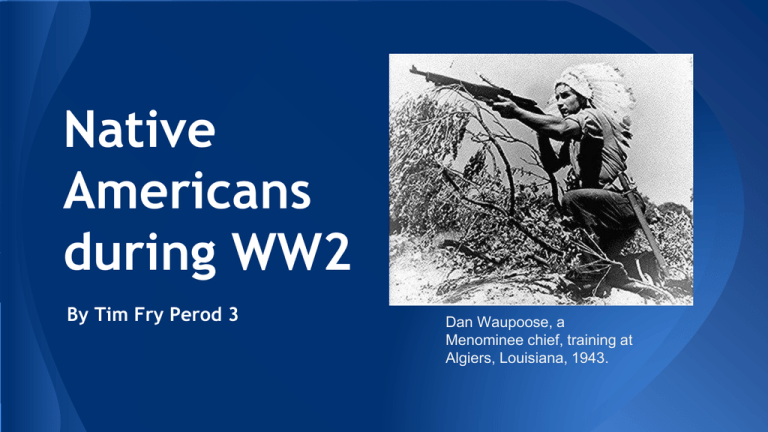Native Americans during WW2 By Tim Fry Perod 3
advertisement

Native Americans during WW2 By Tim Fry Perod 3 Dan Waupoose, a Menominee chief, training at Algiers, Louisiana, 1943. Navajo Code talkers ● One estimate indicates that at the outbreak of World War II, fewer than 30 non-Navajo could understand the language (which was unwritten); therefore, very valuable for the US intelligence community. ● They used their knowledge of Native American languages as a basis to transmit coded messages; their primary job was the sending of secret tactical messages over military telephone or radio. ● Primarily used in the Pacific theater; Hitler had sent anthropologists prior to WW2 to America to learn about the Navajo and other native languages, which made the allies cautious to use the tactic in Europe. ● In the end, the Japanese Imperial Army never cracked the code! They captured only one Navajo marine, who wasn’t able to understand the codes used, even knowing Navajo. Indian code-talkers of the 4th Signal Company (U.S. Army Signal Center and Ft. Gordon) 45th Infantry Division ● Nicknamed the “Thunderbirds”, they were a major formation of the Oklahoma Army National Guard from 1920 to 1968. Headquartered mostly in Oklahoma City, the guardsmen fought in both World War II and the Korean War. ● They were made up largely of Native Americans; they had one of the highest percentages in any division in the Military at the time. ● They took part in intense fighting during the invasion of Sicily and the attack on Salerno in the 1943 Italy Campaign. They held primary roles in the battles of Anzio and in Monte Cassino, and after landing in France during Operation Dragoon, they joined the 1945 drive into Nazi Germany that ended the War in Europe. 45th Infantry Division shoulder sleeve insignia. “Tundra Army” ● The Alaska Territorial Guard (ATG), more commonly the Eskimo Scouts or the Tundra Army, was a military reserve force component of the US Army, organized in 1942 in response to attacks on United States soil in Hawaii and occupation of parts of Alaska by Japan during World War II. ● Included members of the Aleut, Athabaskan, White, Inupiaq, Haida, Tlingit, Tsimshian, and Yupik tribes ● One first-hand estimate states that around 20,000 Alaskans participated, officially or otherwise, in ATG reconnaissance or support activities; however, they saw little action over the course of the war. Life back Home- mixed blessings ● (+) Many Indian men and women left the reservation to work in defense-related industries. A wave of Indian migration from the rural reservations to urban areas was sparked by employment opportunities in the defense industries, lacking workers which had been absorbed for the war effort. ● ● (-) Land was taken from many large Indian reservations by the government, without the consent of the people. In 1942, for example, the federal government established internment camps for Japanese Americans on two Indian reservations: the Gila Indian Reservation and the Colorado River Indian Reservation. (+) Indian Nations helped to support the US cause; they supported the US with tribal money via war bonds, they planted close to 100,000 Victory Gardens to provide food, and many men enlisted to fight (The 6 Iroquois Nations actually declared war on the Axis powers). Lieutenant Ernest Childers, a Muscogee Native member of the 45th Division, being congratulated back home after receiving the Medal of Honor. Discussion Questions 1. What was the value of Native American messengers in World War 2? 2. What were some examples of action Native Americans saw during the war (posts, battles, awards, etc)? 3. What were some ways that Native Americans back home were impacted by World War 2? Bibliographies http://www.alaskool.org/projects/ak_military/akmilitaryindx.htm http://en.wikipedia.org/wiki/45th_Infantry_Division_(United_States) http://www.nmai.si.edu/education/codetalkers/html/ http://www.shsu.edu/~his_ncp/NAWWII.html http://www.history.army.mil/html/topics/natam/index.html http://nativeamericannetroots.net/diary/609





